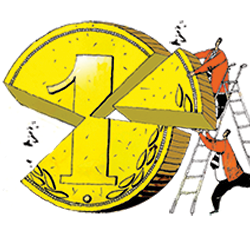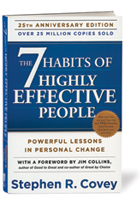
The 7 Habits of Highly Effective People
"I have learned to accept changes
much easier after reading this book."
There's a reason this time-tested business book has made the cut. "The 7 Habits of Highly Effective People" by Stephen R. Covey claims that by gaining self-confidence and becoming more independent at work and home, you'll be better prepared to handle change. Learn how to become less preoccupied with what others think of you and focus on how you relate to them.
What made you pick this book in particular?
"The 7 Habits of Highly Effective People" discusses different perspectives on managing change and working with paradigm shift – how we view the world (or our environment) and change our views based on the circumstances presented. In fact, I've found that paradigm shift was a recurring theme throughout my MBA program.
Many so-called "self-help" books offer little in terms of tangible value. What makes this one different?
Covey won me over with the real-life examples he pulled from his family, colleagues, and workplace. Those examples, paired with clear descriptions of each of the seven habits, made everything he talked about highly relatable for me. There is no mystery to solve or code to crack in this book.
Were you able to apply what you've read to your job as an exhibit manager?
I have learned to accept changes much easier after reading this book. It has helped me work with the budget changes we experienced during the economic downturn and figure out how to be more effective and efficient with the resources available. Now, I'm more strategic while working with our internal teams to ensure success at our events and shows.
Is there anything that has really stuck with you since reading the book?
If I had to identify one primary takeaway, it would be the following line from the chapter titled Habit 1: Be Proactive. Covey writes, "What matters most is how we respond to what we experience in life." For example, when we react negatively to a situation, that negativity affects how others respond. But if we respond positively or proactively, the outcome will be beneficial for everyone.

Dominique Cook, CTSM, trade show coordinator, Marvin Windows and Doors


Change Your Day,
Not Your Life
"Core's book offers solutions in little
nuggets, which
I found helpful
because you need to start somewhere."
If you've ever thought there aren't enough hours in the day to get everything done, then "Change Your Day, Not Your Life" by Andy Core is for you. Learn how to increase productivity and enjoy a healthier lifestyle simply by making small tweaks to your day, rather than sweeping changes that aren't sustainable in the long run.
Where did you get the book?
I took Andy Core's session, "Life Balance – A Healthier You (On the Road)" at EXHIBITOR Show. I struggle with work-life balance, and to complicate it further, I do a lot for family, friends, and organizations, leaving little time for myself. So I was in search of striking a "life-life" balance, too. Core's book offers solutions in little nuggets, which I found helpful because you need to start somewhere.
Can you provide an example of one of the book's "little nuggets," and how you've implemented it?
I don't know about you, but I crash in the middle of the afternoon. Around 3 p.m., I get tired and am not as productive. Core recommends having a healthy snack (a combination of protein and no more than 40 grams of carbohydrates) at 3 p.m. every day to fuel your afternoon. I took this advice, and since I'm a to-do list kind of person, I added this snack to my Outlook calendar so I would remember to take the time to refuel. I also started a daily journal of what I eat, and try as well to check off the boxes with eight glasses of water. And I no longer eat lunch at my desk. Even if it's just a short 15-minute break during a really busy day, getting away from the computer helps you regenerate and reenergize your mind and body.
Why are these tactics particularly useful to exhibit and event marketers?
Much of what Core writes about in the book can be translated to the times when you're on the road working (which is a lot). By implementing little changes to your daily routine, you make the most of every day, whether you're in the office, on the road, or even at home. Who doesn't want to accomplish that? After all, there are 365 days in the year, and you can change one day at a time.

Kathleen Gunderson, CTSM, events program manager, Wells Fargo Home Mortgage

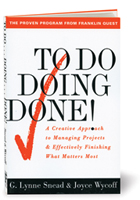
To Do, Doing, Done!
"'To Do, Doing, Done!' allowed me to
take a step back and prioritize my tasks."
"To Do, Doing, Done!" by G. Lynne Snead and Joyce Wycoff is a no-nonsense book. It explains the difference between efficiency and effectiveness – "efficiency is doing things right; effectiveness is doing the right things" – and showcases how to effectively manage and prioritize projects.
What does the book offer exhibit and event marketers?
Event planners are constantly scrambling to do more with less. Being organized, both on paper and in your thoughts, helps significantly with time management. This book provides something for everyone whether it's thought development, time management, organization, and/or project management.
How has reading this book helped you personally?
"To Do, Doing, Done!" allowed me to take a step back and prioritize my tasks. One passage in particular struck a chord with me, "The choice of which tasks [to do] is more important than how they're done." Sometimes we change our tactics and how we go about doing things, but it's equally important to evaluate what we're doing in the first place.
Would you say it helped create a method for your organizational madness?
Definitely. For example, there's a passage that reads, "Successful time management is not about getting more done in a day; it's about getting the things done that matter most." It seems like a basic rule of thumb, but I believe it tends to get overlooked. Now, each day when I go into the office, I look at my huge laundry list of things to accomplish. While 20 tasks may take the same amount of time as one task, perhaps that one task is more important. There is now always a system and method to everything I do. And I am able to leave work every day feeling a greater sense of accomplishment.
If you had to pick one passage from the book to write on a Post-it and stick on your bulletin board, what would it be?
"Destiny is not a matter of chance; it is a matter of choice. It is not a thing to be waited for; it is a thing to be achieved." That quote, from William Jennings Bryan, perfectly summarizes the book's purpose – to teach the reader how to be effective. That's a lesson from which we can all benefit.

Kimberly Greenberg, CMP, CTSM, vice president of marketing, Source Investments

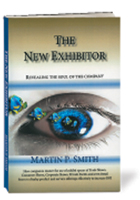
The New Exhibitor
"'The New Exhibitor' explains how
to plan your booth for optimization."
Learn how to identify the soul of your company and help it shine through your exhibit-marketing program in "The New Exhibitor." Written by behaviorist Martin Smith, the book explains how exhibit design drives attendee behavior on the trade show floor.
Why do you think exhibit and event marketers should read this book?
"The New Exhibitor" explains how to plan your booth for optimization. The author helps you figure out the soul of your company by how and what it exhibits, how to bolster attendee attraction, and how to interact with attendees at your trade shows. This book is a great starting point for people who have never done a booth before, as well as people who have been exhibiting for years but might be struggling with not getting results. It prompts you to take a look at what you're doing and how you interact with booth visitors. It's not just about building a pretty booth. You have to give your attendees what they're looking for, which can change from show to show. It also gives you the perspective of the attendee. Sometimes we forget to look at things from their point of view. Ultimately, the trade show isn't about us. It's about them.
Was there a passage or section that resonated with you?
My favorite part is when Smith compares exhibiting to physics. He reminds the reader of Newton's first law of motion, which states that an object in motion will continue in motion unless acted upon by a force. Who would have thought that this same law could be applied to exhibiting? Unless you have a desirable, unique booth to stop them, attendees will keep walking down the aisle.
Does the book address any common misconceptions when it comes to marketing?
Absolutely. A lot of industry people have these supposed "formulas" for how to do trade shows and think they can be applied to every single event. Smith gives readers many great guidelines, but reminds them that each show is different and they have to make adjustments based on what they're exhibiting, who their target audience is, and what they want to get out of the show.

Tim Naegelin, CME, event manager, The Boeing Co.

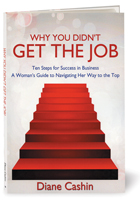
Why You Didn't Get the Job: Ten Steps for Success in Business – A Woman's Guide to Navigating Her Way to the Top
"While it is a quick read, it is filled with
thought-provoking exercises and worksheets."
In this book, Diane Cashin provides motivated individuals with a tool kit for taking their careers to the next level, or for changing careers entirely. Presented in 10 steps, the book provides a blueprint for gaining recognition, having a voice that gets heard, and getting a seat at the boardroom table.
In your opinion, what differentiates this book?
It's a relatively quick read, but it's filled with thought-provoking exercises and worksheets, and each of the 10 main steps include a multitude of smaller steps, a lot of self-reflection, and a good deal of tasks. "Why You Didn't Get the Job" isn't something you read, nod your head, and put back on the shelf. It's a handy book to refer to again and again as you work through the sections separately or simultaneously, at different times in your life or career.
Do you learn something new each time you pick it up?
The first time I read it, my favorite part was the introduction, wherein Cashin advises readers to find their "true north." She encourages readers to be brutally honest and make an investment in their futures. I'm intrigued by the concept of finding my true north, and I find it a little daunting. What if I discover that I'm not who I thought I was or that I should be in another career? Well, after reading this book twice in the past month, I've come to realize that there's nothing wrong with a little self-discovery.
How can you apply this idea of true north to your personal life?
The second time I read it, I found another favorite part, and this one is a quote from Chapter 1 (Step 1): "Stop watching reality television unless the show is geared toward developing a passion or skill of yours, like cooking or home design. Fill your life with activities that benefit you, your dreams, your wishes, and your desires and stop watching someone else's life on television – go live yours!" So find your own true north, and then, even if you take the scenic route sometimes, you will always stay the course.

Diane Benson, CTSM, global events manager, GE Healthcare

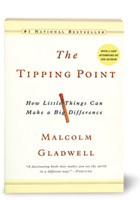
The Tipping Point: How Little Things Can Make a Big Difference
"I love to read about concrete problems
and the solutions adopted to solve them."
"The Tipping Point" is about a phenomenon coined by author Malcolm Gladwell to describe how very small changes can have a big impact. In this book, he hypothesizes that ideas, messages, and products can spread like viruses and can be adopted by a large number of people. In order to prove the existence of the tipping point, he uses compelling examples to show how certain trends are adopted.
The "tipping point" seems like an abstract concept. Was it difficult to grasp?
Not at all. The book is actually a fun read. Gladwell's writing style is accessible and draws you in with a variety of anecdotes to showcase the idea that small changes can really lead to dramatic results. His stories range from the American Civil War and the huge spike in popularity of Hush Puppies shoes to the incredible viewership of "Sesame Street." And each of those stories is descriptive, containing examples to explain the key concepts outlined. For instance, Gladwell cites the huge drop in New York crime in the 1980s, and explains how the drop is attributable to very small but clearly impactful changes. I love to read about concrete problems and the solutions adopted to solve them.
This book is a go-to business book for many industries. What makes it helpful for exhibit and event marketers?
Exhibit and event marketers often feel that unless they implement dramatic changes to their programs, they won't garner the results they want or draw traffic to their booths. This book certainly helped me take a step back from my program to see how small tweaks could have a more dramatic impact and help me reach certain goals. Aside from being a really interesting read, this book is a great asset to any library of event-management resources.
If you had to explain the book in one tweet, what would it say?
Slow down, take a look at your program as a whole, and see where small changes can have the biggest impact for your events.

Erica Deri, events manager, Genetec






 Dominique Cook, CTSM, trade show coordinator, Marvin Windows and Doors
Dominique Cook, CTSM, trade show coordinator, Marvin Windows and Doors 
 Kathleen Gunderson, CTSM, events program manager, Wells Fargo Home Mortgage
Kathleen Gunderson, CTSM, events program manager, Wells Fargo Home Mortgage
 Kimberly Greenberg, CMP, CTSM, vice president of marketing, Source Investments
Kimberly Greenberg, CMP, CTSM, vice president of marketing, Source Investments 
 Tim Naegelin, CME, event manager, The Boeing Co.
Tim Naegelin, CME, event manager, The Boeing Co.
 Diane Benson, CTSM, global events manager, GE Healthcare
Diane Benson, CTSM, global events manager, GE Healthcare
 Erica Deri, events manager, Genetec
Erica Deri, events manager, Genetec

